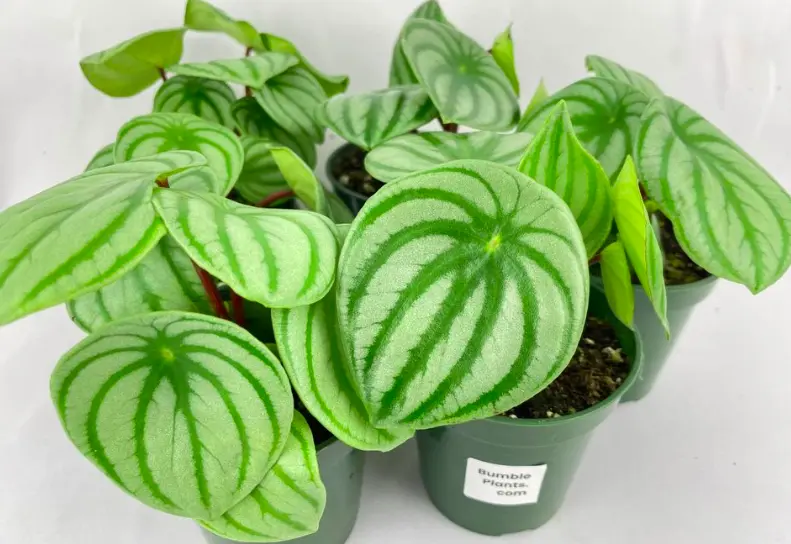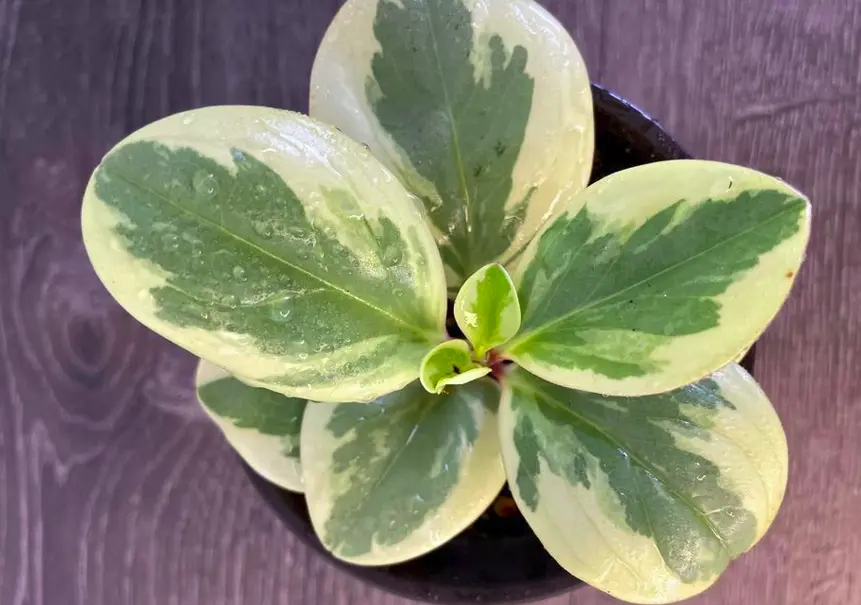In the world of houseplants, one variety that has been gaining popularity in recent years is variegated peperomia. This brightly-colored, medium-sized houseplant adds an elegant touch to any room or patio and is relatively easy to grow and care for.
The Peperomia plant is an excellent choice for inexperienced houseplant lovers. In addition to being tolerant plants that can withstand mild neglect, its stunning diversity of textures and colors ensures that you can build a fascinating collection of plants for any style requiring the same maintenance.
You’ll want to keep reading to know what it entails to grow and care for variegated peperomias.
What is a Variegated Peperomia?

Peperomia Variegata is a gorgeous variegated variety of the Baby Rubber Plant with all of the same beloved characteristics as the original, but with the added benefit of vibrant shades of olive green, dark green, and a lovely creamy white. It’s a bushy, upright plant with thick stems and glossy, plump curved leaves.
The glossy leaves of variegated peperomia come in cream-colored variations that form marbled patterns on the green leaves. They can grow in brilliant indirect light or partial sun but not in direct sunlight. On the other hand, diseases and insects are rarely a concern with variegated peperomia.
Peperomia is a houseplant that is easy to care for, attractive, and can thrive in low-light conditions. Variegated peperomia has green leaves with a white or yellow stripe down the middle. This is a great plant because it requires little water, thrives in low light conditions, and doesn’t need much soil depth. It also grows slowly enough that you won’t need to re-pot it often.
Varieties of the Peperomia Plant
Peperomia comes in a wide range of varieties and species, many of which you can grow as houseplants. Some examples include the following:
Peperomia Clusiifolia

This variety is an excellent way to diversify your plant collection and is widely available in most regions. Other names, such as Tricolor, the Jelly, and Ginny Peperomia, also know it. Clusiifolia is a great beginner plant; the leaf is most vibrant in bright, indirect light.
On the other hand, this is a love-or-hate plant: some loathe the muddy coloring and uncontrolled growth, while others adore the pastel colors and wacky leaves. The enthusiasts are winning, as this plant’s popularity remains rising.
Peperomia Argyreia

This bright cultivar, often known as the Watermelon Peperomia, tops the charts regarding instant appeal and popularity. The shiny green leaves comprise off-center, beautiful silver veins and crimson stems resembling a watermelon’s interior.
Peperomia Argyreia is among the most common varieties, so you won’t have any problem finding it locally, and it appears to be available everywhere online. The variegated variant is also accessible and popular. However, it is not the simplest species to manage for newbies. It prefers humidity and a light atmosphere but will thrive without either.
Peperomia Obtusifolia

This popular plant has spherical leaves on stout stems that grow in a zigzag pattern nearly a foot long. It comprises smooth and lustrous semi-succulent leaves and prefers strong indirect light. Peperomia Obtusifolia can tolerate a shaded area and practically everything except overwatering. It could do better with repotting regularly and is best kept in its nursery container.
Peperomia Tetragona

This distinctive cultivar, sometimes known as the Parallel Peperomia, has almond-shaped leaves with sharp, thin strips of off-white and green that exists parallel to the midvein. The Tetragona is semi-tropical and prefers increased humidity but can adapt to lower levels. Despite its clean-cut, precise appearance, this is not a fussy plant. It grows erect until the stems get too tall to topple over, at which point it can be cultivated as a small shrub or as a hanging plant.
Peperomia Orba

This popular trailing species, often known as the Teardrop Peperomia, stays fresh and perky all year. It’s only around six inches tall and wide, so it won’t take up too much room. The little oval leaves are somewhat fuzzy and glossy, with a clean midrib indentation.
Peperomia Orba is a popular Peperomia variety that has inspired several collections, such as Astrid, Variegata, and Pixie Lime. This is a low-maintenance semi-succulent: nonetheless, avoid overwatering! Furthermore, it favors strong indirect light yet is hardy in general.
Propagating Variegated Peperomia
Variegated peperomia are typically grown as a hanging plant or in a pot with the soil surface level with the rim of the pot. You can propagate peperomia plants at any time of year, although the ideal period is likely to be in the spring. If you intend to trim your plants in the springtime, you can propagate from a stem cutting.
Here’s how to do it:
- You’ll need sterile scissors or pruning snips, orchid mix or potting soil, plastic wrap, a tiny container, and a well-lit spot to start.
- Remove a leaf and at least 1 inch of stem from the mother plant.
- Place the slice, cut end down, in a pot filled with potting soil.
- Position it in a bright spot with plenty of indirect light.
- Create a mini-greenhouse atmosphere with plastic wrap to help it maintain moisture.
- Water regularly and never allow the soil to dry out. Within a few weeks, roots will sprout; once they do, you can transfer the cutting into a larger container.
Growing Peperomia from Leaf Cuttings
- Cut and remove huge leaves and stems using a sterilized garden tool.
- To boost the chances of success, immerse the leaf stalk in the rooting hormone.
- Place the leaves in a container of seedling starting soil.
- Place the container in a light, warm location until new growth appears.
- Move the seedling to a permanent container.
Caring for Variegated Peperomia
Variegated peperomias are easy to care for, come in various colors, and thrive with minimal effort. Here are a few ways you can take care of your plant:
Fertilizer
Fertilize every other week with slow-release fertilizer pellets during the growth season, or use a diluted liquid fertilizer at the start of the growing season. Remember to only fertilize over the winter.
Humidity and Temperature
Peperomia plants thrive in temperatures ranging from 65 to 80 degrees Fahrenheit. However, protect them from wind and drafts from heating and air-conditioning vents, which produce significant temperature changes. Furthermore, they enjoy humidity levels ranging from mild to high. Put the plant on a tray filled with water and pebbles to boost humidity levels, or mist the leaves while keeping the water away from the pot’s bot.
Water
These plants want frequent watering, but not so much that the soil becomes moist. Allow the soil to dry completely between watering. Reduce watering slightly in the late autumn and winter whenever the plant isn’t actively growing.
Soil
Peperomia plants require well-draining soil, or they can suffer root rot. Choose a peat moss-based houseplant potting mix. For an optimal growing condition for your peperomia plant, mix in a generous amount of orchid bark.
Light
Peperomia does not require direct sunlight and likes to thrive in partial shade. Avoid direct afternoon sunlight on the plants, which can scorch the leaves. Place them indoors, where they will receive indirect light from a window. They also grow nicely under fluorescent lights.
Common Problems of Variegated Peperomia
There aren’t many issues with variegated peperomia. However, if you notice any of the following problems, act quickly to save your plant.
Pests
Pests Peperomia plants are vulnerable to typical pests that attack most houseplants, including whiteflies, spider mites, and mealybugs. The most basic treatment for these pests is to use insecticidal soap.
Falling Leaves
It’s typical for your variegated peperomia to lose a few bottom leaves, so don’t be frightened. On the other hand, a dramatic temperature shift or a fertilizer issue frequently causes a big leaf drop.
Wilted Leaves
Overwatering can cause your variegated peperomia to wilt or develop raised, scab-like bulges on the leaves. They prefer high humidity and mild soil moisture as houseplants, although they are susceptible to overwatering.
Yellowing Leaves
When your variegated peperomia leaves curl or turn yellow, it usually implies the plant is getting too much water. The fastest solution is to remove the yellowed leaves.
Variegated peperomia is an excellent houseplant guaranteed to add color to your winter space. All you need to do is stick with the care process outlined above, and you shouldn’t have any problems with your plant. Just make sure that it gets plenty of light and water, feed it once in a while, and you’ll be on your way to growing an incredible-looking variegated peperomia.
